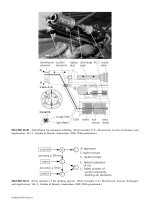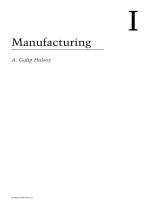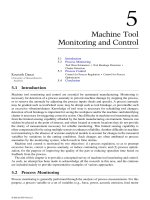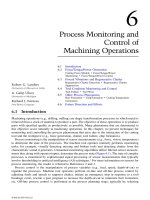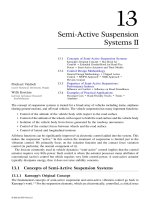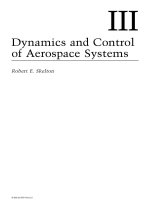Computational Chemistry and Molecular Modeling ppt
Bạn đang xem bản rút gọn của tài liệu. Xem và tải ngay bản đầy đủ của tài liệu tại đây (5.17 MB, 405 trang )
Computational Chemistry and Molecular Modeling
K. I. Ramachandran · G. Deepa · K. Namboori
Computational Chemistry
and Molecular Modeling
Principles and Applications
123
Dr. K. I. Ramachandran
Dr. G. Deepa
K. Namboori
Amrita Vishwa Vidyapeetham Univ ersity
Computational Engineering and Networking
641 105 Ettimadai
Coimbatore
India
ISBN-13 978-3-540-77302-3 e-ISBN-13 978-3-540-77304-7
DOI 10.1007/978-3-540-77304-7
© 2008 Springer-Verlag Berlin Heidelberg
Library of Congress Control Number: 2007941252
This work is subject to copyright. All rights are reserved, whether the whole or part of the material is
concerned, specifically the rights of translation, reprinting, reuse of illustrations, recitation, broadcasting,
reproduction on microfilm or in a ny other way, and storage in data banks. Duplication of this publication
or parts thereof is permitted only under the provisions of the German Copyright Law of September 9,
1965, in its current version, and permission for use must always be obtained from Springer. Violations
are liable to prosecution under the German Cop yright Law.
The use of general descriptive names, registered names, trademarks, etc. in this publication does not
imply, ev en in the absence of a specific statement, that such names are exempt from the relevant pr otective
laws and regulations and therefore free for general use.
Cover design: KünkelLopka, Heidelberg
Typesetting and Production: le-tex publishing services oHG
Printed on acid-free paper
987654321
springer.com
Dedicated to the lotus feet of
Our Beloved Sadguru and Divine Mother
Sri MATA AMRITANANDAMAYI DEVI
Preface
Computational chemistry and molecular modeling is a fast emerging area which is
used for the modeling and simulation o f small chemical and biological systems in
order to understand and predict their behavior at the molecular level. It has a wide
range of applications in various disciplines of engineering sciences, such as materi-
als science, chemical engineering, biomedical engineering, etc. Knowledge of com-
putational chemistry is essential to understand the behavior of nanosystems; it is
probably the easiest route or gateway to the fast-growing discipline of nanosciences
and nanotechnology, which covers many areas of research dealing with objects that
are measured in nanometers and which is expected to revolutionize the industrial
sector in the coming decades.
Considering the importance of this discipline, computational chemistry is being
taught presently as a course at the postgraduate and research level in many universi-
ties. This book is the result of the need for a comprehensive textbook on the subject,
which was felt by the authors while teaching the course. It covers all the aspects of
computational chemistry required for a course, with sufficient illustrations, numer i-
cal examples, applications, and exercises. For a computational chemist, scientist, or
researcher, this book will be highly useful in understanding and mastering the art of
chemical com putation. Familiarization with common an d commercial software in
molecular modeling is also incorporated. Moreover, the application of the concepts
in related fields such as biomedical engineering, computational drug designing, etc.
has been added.
The book begins with an introductory chapter on computational chemistry and
molecular modeling. In this chapter (Chap. 1), we emphasize the four computa-
tional criteria for modeling any system, namely stability, symmetry, quantization,
and homogeneity. In Chap. 2, “Symmetry and Point Groups”, elements of molec-
ular symmetry and point group are explained. A numb er of illustrative examples
and diagrams are given. The transformation matrix for each symmetry operation
is included to provide a computational know-how. In Chap. 3, the basic princi-
ples of quantum mechanics are presented to enhance the reader’s ability to under-
stand the quantum mechanical modeling techniques. In Chaps. 4–10, computational
techniques with different levels of accuracy have been arranged. The chapters also
vii
viii Preface
cover Huckel’s molecular orbital theory, Hartree-Fock (HF) approximation, semi-
empirical methods, ab initio techniques, density functional theory, reduced density
matrix, and molecular mechanics methods.
Topics such as the overlap integral, the Coulomb integral and the resonance inte-
gral, the secular matrix, and the solution to the secular matrix have been included in
Chap. 4 with specific applications such as aromaticity, charge density calculation,
the stability and delocalization energy spectrum, the hig hest occupied molecular or-
bital (HOMO), the lowest unoccupied molecular orbital (LUMO), bond order, the
free valence index, the electrophilic and nucleophilic substitution, etc. In the chap-
ter on HF theory (Chap. 5), the formulation of the Fock matrix has been included.
Chapter 6 concerns different types of basis sets. This chapter covers in detail all
important minimal basis sets and extended basis sets such as GTOs, STOs, double-
zeta, triple-zeta, quadrup le-zeta, split-valence, po larized, and diffuse. In Chap. 7,
semi-empirical methods are introduced; besides giving an overview of the theory
and equations, a performance of the methods based on the neglect of differential
overlap, with an emphasis o n AM1, MNDO, and PM3 is explained. Chapter 8 is
on ab initio methods, covering areas such as the correlation technique, the Möller-
Plesset perturbation theory, the generalized valence bond (GVB) method, the multi-
configurations self consistent field (MCSCF) theory, configuration interaction (CI)
and coupled cluster theory (CC).
Density functional theory ( DFT) seems to be an extremely successful approach
for the description of the ground state p roperties of metals, semiconductors, and in-
sulators. The success of DFT not only encompasses standard bulk materials but also
complex materials such as proteins and carbon nanotubes. The chapter on density
functional theory (Chap. 9) covers the entire applications of the theory.
Chapter 10 explains red uced density matr ix and its applications in molecular
modeling. While traditional methods for computing the orbitals are scaling cubically
with respect to the number of electrons, the computation of the density matrix offers
the opportunity to achieve linear complexity. We describe several iteration schemes
for the computation of the density matrix. We also briefly present the concept of the
best n-term approximation.
Chapter 11 is on molecular mechan ics and modeling , in which various force
fields required to express the total energy term are introduced. Computations using
common molecular mechanics force fields are explained.
Computations of molecular properties u sing the common computational tech-
niques are explained in Chap. 12. In this chapter, we have included a section on
a comparison of various modeling techniques. This helps the reader to choose the
method for a particular computation.
The need and the possibility for high performance computing (HPC) in molecular
modeling is explained in Chap. 13. This chapter explains HPC as a technique for
providing the foundation to meet the data and computing demands of Research and
Development (R&D) grids. HPC helps in harnessing data and computer resources
in a multi-site, multi-organizational context effective cluster management, making
use o f maximum computing investment for molecular modeling.
Preface ix
Some typical projects/research topics on molecular modeling are included in
Chap. 14. This chapter helps the reader to familiarize himself with th e modern trends
in research connected with computational chemistry and molecular modeling.
Chapter 15 is on basic mathematics and contains an introduction to compu-
tational tools such as Microsoft Excel, MATLAB, etc. This helps even a non-
mathematics person to understand the mathematics used in the text to appreciate
the real art of computing. Sufficient additions have been included as an appendix
to cover areas such as operators, HuckelMO hetero atom p arameters, Microsoft Ex-
cel in the balancing of chemical equations, simultaneous spectroscopic analysis, the
computation of bond enthalpy of hydrocarbons, graphing chemical analysis data,
titration data plotting, the application of curve fitting in chemistry, the determina-
tion of solvation energy, and the determination of partial m olar volume.
An exclusive URL ( for this book with the re-
quired support materials has been provided for readers which contains a chapterwise
PowerPoint presentation, numerical solutions to exercises, the input/output files of
computations done with software such as Gaussian, Spartan etc., HTML-based pro-
gramming environments for the determination of eigenvalues/eigenvectors of sym-
metrical matrices and interconversion of units, and the step-by-step implementation
of cluster computing. A comprehensive survey covering the possible journals, pub-
lications, software, and Internet support concerned with this discipline have been
included.
The uniqueness of this book can be summarized as follows:
1. It provides a comprehensive background theory for molecular modeling.
2. It includes applications from all related ar eas.
3. It includes sufficient numerical examples and exercises.
4. Numerous explanatory illustrations/figures are included.
5. A separate chapter on basic mathematics and application tools such as MAT-
LAB is included.
6. A chapter on high performance computing is included with examples from
molecular modeling.
7. A chapter on chemical computation using the reduced density matrix method is
included.
8. Sample projects and research topics from the area are included.
9. It includes an exclusive web site with required support materials.
With the vast teaching expertise of the authors, the arrangement and designing
of the topics in the book has been made according to the requirements/interests
of the teaching/learning community. We hope that the reader community appre-
ciates this. Computational chemistry principles extended to molecular simulation
are not included in this book; we hope that a sister publication of this book cov-
ering that aspect will be released in the near f uture. We have tried to make the
explanations clear and complete to the satisfaction of the reader. However, re-
garding any queries, suggestions, corrections, modifications and advice, the read-
ers are always welcome to contact the authors at the following email address:
x Preface
The authors would like to take this opportunity to acknowledge the following
persons who spend their valuable time in discussions with the authors and helped
them to enrich this book with their suggestions and comments:
1. Brahmachari Abhayamrita Chaitanya, the Chief Operating Officer of Amrita
University, and Dr. P. Venkata Rang an, the Vice Chancellor of Amrita Univer-
sity, for their unstinted support and constant encouragement in all our endeav-
ours.
2. Dr. C. S. Shastry, Professor of the Department of Science, for his insightful
lectures on quantum mechanics.
3. Mr. K. Narayanan Kutty of the Department of Science, for his contribution to
the chapter on quantum mechanics.
4. Mr. G. Narayanan Nair of the Systems Department, for his contribution to the
sectiononHPC.
5. Mr. M. Sreevalsan, Mr. P. Gopakumar and Mr. Ajai Narendran of the Systems
Department, for their help in making the website for the book.
6. Dr. K. P. Soman, Head of the Centre for Computational Engineering and Net-
working, for his continuous support and encouragement.
7. Mr. K. R. Sunderlal and Mr. V. S. Binoy from the interactive media group of
‘Amrita Vishwa Vidyapeetham-University’ for drawing excellent diagrams in-
cluded in the book.
8. All our colleagues, dear and near ones, friends and students for their cooperation
and support.
9. All the officials of Springer-Verlag Berlin Heidelberg and le-tex publishing
services oHG, Leipzig for materializing this project in a highly appreciable man-
ner.
Coimbatore, March 2008 K. I. Ramachandran
Gopakumar Deepa
Krishnan Namboori P.K.
Contents
1 Introduction 1
1.1 A Definition of Computational Chemistry 1
1.2 Models 2
1.3 Approximations 3
1.4 Reality 4
1.5 Computational Chemistry Methods 4
1.5.1 Ab Initio Calculations 5
1.5.2 SemiempiricalCalculations 6
1.5.3 ModelingtheSolidState 6
1.5.4 MolecularMechanics 7
1.5.5 MolecularSimulation 7
1.5.6 StatisticalMechanics 8
1.5.7 Thermodynamics . . . 8
1.5.8 Structure-PropertyRelationships 8
1.5.9 SymbolicCalculations 9
1.5.10 Artificial Intelligence 9
1.5.11 TheDesignofaComputationalResearchProgram 9
1.5.12 Visualization 10
1.6 Journals and Book Series Focusing
onComputationalChemistry 10
1.7 Journals and Book Series
OftenIncludingComputationalChemistry 11
1.8 Common Reference Books Available
onComputationalChemistry 11
1.9 ComputationalChemistryontheInternet 13
1.10 Some Topics of Research Interest Related
toComputationalChemistry 14
References 15
xi
xii Contents
2 Symmetry and Point Groups 17
2.1 Introduction 17
2.2 SymmetryOperationsandSymmetryElements 17
2.3 SymmetryOperationsandElementsofSymmetry 18
2.3.1 The Identity Operation . . . 18
2.3.2 RotationOperations 19
2.3.3 ReflectionPlanes(orMirrorPlanes) 22
2.3.4 InversionOperation 25
2.3.5 ImproperRotations 26
2.4 Consequences for Chirality . 26
2.5 Point Groups . . . 27
2.6 The Procedure for Determining the Point Group of Molecules . . . . 28
2.7 TypicalMolecularModels 30
2.8 GroupRepresentationofSymmetryOperations 32
2.9 Irreducible Representations . 33
2.10 LabelingofElectronicTerms 34
2.11 Exercises 34
2.11.1 Questions 34
2.11.2 AnswerstoSelectedQuestions 34
References 35
3 Quantum Mechanics: A Brief Introduction 37
3.1 Introduction 37
3.1.1 The Ultraviolet Catastrophe . . . 37
3.1.2 ThePhotoelectricEffect 38
3.1.3 The Quantization of the Electronic Angular Momentum . . 39
3.1.4 Wave-Particle Duality . . . 39
3.2 TheSchrödingerEquation 41
3.2.1 TheTime-IndependentSchrödingerEquation 41
3.2.2 TheTime-DependentSchrödingerEquation 43
3.3 TheSolutiontotheSchrödingerEquation 45
3.4 Exercises 45
3.4.1 Question1 45
3.4.2 Answer1 45
3.4.3 Question2 46
3.4.4 Answer2 46
3.4.5 Question3 46
3.4.6 Answer3 46
3.4.7 Question4 47
3.4.8 Answer4 47
3.4.9 Question5 48
3.4.10 Answer5 48
3.4.11 Question6 48
3.4.12 Answer6 48
3.4.13 Question7 49
Contents xiii
3.4.14 Answer7 49
3.4.15 Question8 50
3.4.16 Answer8 50
3.4.17 Question9 50
3.4.18 Answer9 50
3.4.19 Question10 51
3.4.20 Answer10 51
3.5 Exercises 51
References 52
4 Hückel Molecular Orbital Theory 53
4.1 Introduction . 53
4.2 TheBorn-OppenheimerApproximation 53
4.3 IndependentParticleApproximation 56
4.4
π
-ElectronApproximation 58
4.5 Hückel’sCalculation 58
4.6 TheVariationalMethodandtheExpectationValue 59
4.7 TheExpectationEnergyandtheHückelMO 60
4.8 The Overlap Integral (S
ij
) 62
4.9 The Coulomb Integral (
α
) 63
4.10 The Resonance (Exchange) Integral (
β
) 63
4.11 TheSolutiontotheSecularMatrix 63
4.12 Generalization 64
4.13 TheEigenvectorCalculationoftheSecularMatrix 66
4.14 TheChemicalApplicationsofHückel’sMOT 66
4.15 ChargeDensity 67
4.16 TheHückel(4n+2)RuleandAromaticity 69
4.17 TheDelocalizationEnergy 71
4.18 EnergyLevelsandSpectrum 73
4.19 WaveFunctions 74
4.19.1 Step 1: Writing the Secular Matrix . . . . 74
4.19.2 Step2:SolvingtheSecularMatrix 74
4.20 BondOrder 77
4.21 TheFreeValenceIndex 78
4.22 Molecules with Nonbonding Molecular Orbitals 80
4.23 The Prediction of Chemical Reactivity . . . 81
4.24 TheHMOandSymmetry 82
4.25 MoleculesContainingHeteroatoms 85
4.26 TheExtendedHückelMethod 86
4.27 Exercises 88
References 91
xiv Contents
5 Hartree-Fock Theory 93
5.1 Introduction 93
5.2 TheHartreeMethod 93
5.3 BosonsandFermions 96
5.4 Spin Multiplicity 96
5.5 TheSlaterDeterminant 97
5.6 PropertiesoftheSlaterDeterminant 99
5.7 TheHartree-FockEquation 99
5.8 TheSecularDeterminant 104
5.9 RestrictedandUnrestrictedHFModels 104
5.10 TheFockMatrix 106
5.11 Roothaan-HallEquations 106
5.12 ElementsoftheFockMatrix 107
5.13 StepsfortheHFCalculation 110
5.14 Koopman’s Theorem . . 110
5.15 ElectronCorrelation 110
5.16 Exercises 112
References 113
6BasisSets 115
6.1 Introduction 115
6.2 TheEnergyCalculationfromtheSTOFunction 117
6.3 The Energy Calculatio n of Multielectron Systems . . 120
6.4 GaussianTypeOrbitals 121
6.5 DifferencesBetweenSTOsandGTOs 122
6.6 ClassificationofBasisSets 124
6.7 MinimalBasisSets 124
6.8 A Comparison of Energy Calculations of the Hydrogen Atom
BasedonSTO-nGBasisSets 125
6.8.1 STO-2G 125
6.8.2 STO-3G 125
6.8.3 STO-6G 126
6.9 ContractedGaussianTypeOrbitals 126
6.10 Double- and Triple-Zeta Basis Sets
and the Split-Valence Basis Sets . . 128
6.11 PolarizedBasisSets 130
6.12 BasisSetTruncationErrors 133
6.13 Basis Set Superposition Error 133
6.14 Methods to Overcome BSSEs 135
6.14.1 TheChemicalHamiltonianApproach 135
6.14.2 The Counterpoise Method 135
6.15 The Intermolecular Interaction Energy
ofIonWaterClusters 136
6.16 AListofCommonlyAvailableBasisSets 137
6.17 InternetResourcesforGeneratingBasisSets 137
Contents xv
6.18 Exercises 138
References 138
7 Semiempirical Methods 139
7.1 Introduction . 139
7.2 TheNeglectofDifferentialOverlapMethod 140
7.3 TheCompleteNeglectofDifferentialOverlapMethod 140
7.4 TheModifiedNeglectoftheDiatomicOverlapMethod 140
7.5 TheAustinModel1Method 141
7.6 TheParametricMethod3Model 141
7.7 ThePairwizeDistanceDirectedGaussianMethod 142
7.8 TheZeroDifferentialOverlapApproximationMethod 142
7.9 TheHamiltonianintheSemiempiricalMethod 143
7.9.1 The Computation of H
core
r
A
s
B
145
7.9.2 The Computation of H
core
r
A
r
A
145
7.10 Comparisons of Semiempirical Methods . 148
7.11 SoftwareUsedforSemiempiricalCalculations 153
7.12 Exercises 153
References 154
8 The Ab Initio Method 155
8.1 Introduction . 155
8.2 TheComputationoftheCorrelationEnergy 156
8.3 TheComputationoftheSDoftheExcitedStates 157
8.4 ConfigurationInteraction 158
8.5 SecularEquations 159
8.6 Many-BodyPerturbationTheory 159
8.7 TheMöller-PlessetPerturbation 161
8.8 The Coupled Cluster Method . 165
8.9 ResearchTopics 168
8.10 Exercises 168
References 170
9 Density Functional Theory 171
9.1 Introduction . 171
9.2 ElectronDensity 171
9.3 PairDensity 172
9.4 TheDevelopmentofDFT 172
9.5 TheFunctional 173
9.6 TheHohenbergandKohnTheorem 174
9.7 TheKohnandShamMethod 178
9.8 ImplementationsoftheKSMethod 180
9.9 DensityFunctionals 181
9.10 The Dirac-Slater Exchange Energy Functional and the Potential. . . 182
xvi Contents
9.11 The von Barth-Hedin Exchange Energy Functional
andthePotential 183
9.12 TheBeckeExchangeEnergyFunctionalandthePotential 183
9.13 The Perdew-Wang 91 Exchange Energy Functional
andthePotential 184
9.14 The Perdew-Zunger LSD Correlation Energy Functional
andthePotential 185
9.15 TheVosko-Wilk-NusairCorrelationEnergyFunctional 186
9.16 The von Barth-Hedin Correlation Energy Functional
andthePotential 186
9.17 The Perdew 86 Correlation Energy Functional and the Potential . . . 187
9.18 The Perdew 91 Correlation Energy Functional and the Potential . . . 187
9.19 The Lee, Yang, and Parr Correlation Energy Functional
andthePotential 188
9.20 DFT Methods . . . 189
9.21 ApplicationsofDFT 190
9.22 ThePerformanceofDFT 191
9.23 AdvantagesofDFTinBiologicalChemistry 192
9.24 Exercises 192
References 193
10 Reduced Density Matrix 195
10.1 Introduction 195
10.2 ReducedDensityMatrices 195
10.3 N-Representability Conditions . . . . 197
10.3.1 G-Condition (Garrod) and Percus . . . . 198
10.3.2 T-Conditions(Erdahl) 198
10.3.3 T2 Condition . 198
10.4 ComputationsUsingtheRDMMethod 199
10.5 TheSDPFormulationoftheRDMMethod 199
10.6 ComparisonofResults 201
10.7 ResearchinRDM 201
10.8 Exercises 202
References 202
11 Molecular Mechanics 205
11.1 Introduction 205
11.2 TriadTools 206
11.3 TheMorsePotentialModel 207
11.4 The Harmonic Oscillator Mo del for Molecules 208
11.5 The Comparison of the Morse Potential
withtheHarmonicPotential 209
11.6 TwoAtomsConnectedbyaBond 210
11.7 PolyatomicMolecules 211
11.8 EnergyDuetoStretching 212
Contents xvii
11.9 EnergyDuetoBending 212
11.10 EnergyDuetoStretch-BendInteractions 212
11.11 EnergyDuetoTorsionalStrain 213
11.12 EnergyDuetovanderWaalsInteractions 213
11.13 EnergyDuetoDipole-DipoleInteractions 213
11.14 TheLennard-JonesTypePotential 214
11.15 TheTruncatedLennard-JonesPotential 214
11.16 TheKiharaPotential 215
11.17 The Exponential -6 Potential . 215
11.18 TheBFWTwo-BodyPotential 216
11.19 The Ab Initio Potential . 216
11.20 TheIonicandPolarPotential 216
11.21 CommonlyAvailableForceFields 217
11.21.1 MM2,MM3,andMM4 217
11.21.2 AMBER 218
11.21.3 CHARMM 219
11.21.4 MerckMolecularForceField 219
11.21.5 TheConsistentForceField 222
11.22 SomeOtherUsefulPotentialFields 222
11.23 TheMeritsandDemeritsoftheForceFieldApproach 223
11.24 Parameterization 224
11.25 SomeMMSoftwarePackages 225
11.26 Exercises 225
References 227
12 The Modeling of Molecules Through Computational Methods 229
12.1 Introduction . 229
12.2 Optimization 229
12.2.1 MultivariableOptimizationAlgorithms 229
12.2.2 LevelSets,LevelCurves,andGradients 230
12.2.3 Optimality Criteria . . 232
12.2.4 TheUnidirectionalSearch 233
12.2.5 Finding the Minimum Point Along S
t
233
12.2.6 Gradient-Based Methods . . 234
12.2.7 TheMethodofSteepestDescent 235
12.2.8 TheMethodofConjugateDirections 238
12.2.9 TheGram-SchmidtConjugationMethod 240
12.2.10 TheConjugateGradientMethod 241
12.3 Potential Energy Surfaces 243
12.3.1 ConvergenceCriteria 244
12.3.2 CharacterizingStationaryPoints 245
12.4 Th e Search for Transition States . . . 245
12.4.1 ComputingtheActivatedComplexFormation 246
12.5 TheSinglePointEnergyCalculation 249
12.6 TheComputationofSolvation 250
xviii Contents
12.6.1 TheTheoryofSolvation 250
12.6.2 TheSolventAccessibleSurfaceArea 251
12.6.3 TheOnsagerModel 251
12.6.4 ThePoissonEquation 251
12.6.5 TheSelf-ConsistentReactionFieldCalculation 251
12.6.6 The Self-Consistent Isodensity
Polarized Continuum Model . . . 252
12.7 The Population Analysis Method . 253
12.7.1 The Mulliken Population Analysis Method . 253
12.7.2 The Merz-Singh-Kollman Scheme . . . 254
12.7.3 Charges from Electrostatic Potentials
UsingaGrid-BasedMethod(CHELPG) 255
12.7.4 The Natural Population Analysis Method . . 255
12.8 Shielding 256
12.9 ElectricMultipolesandMultipoleMoments 257
12.9.1 TheQuantumMechanicalDipoleOperator 258
12.9.2 TheDielectricPolarization 259
12.10 VibrationalFrequencies 260
12.11 Thermodynamic Properties . 262
12.12 Molecular Orbital Methods . 263
12.13 Input Formats for Computations . . 264
12.13.1 The Z-Matrix Input as the Common Standard Format . . . . 264
12.13.2 MultipurposeInternetMailExtensions 265
12.13.3 ConvertingBetweenFormats 266
12.14 A Comparison of Methods . . 268
12.14.1 MolecularGeometry 268
12.14.2 EnergyChanges 270
12.14.3 DipoleMoments 271
12.14.4 Generalizations 272
12.15 Exercises 272
References 274
13 High Performance Computing 275
13.1 Introduction – Supercomputers vs. Clusters . . . 275
13.2 Clustering 275
13.3 HowClustersWork 276
13.4 ComputationalClusters 277
13.5 ClusteringToolsandLibraries 277
13.6 TheClusterArchitecture 278
13.7 Clustermatic 279
13.8 LinuxBIOS . 280
13.9 BProc 280
13.10 Configuration 280
13.11 Setup 281
13.12 TheStepstoConfigureaCluster 281
Contents xix
13.13 Clustering Through Windows 282
13.13.1 NetworkLoadBalancingClusters 282
13.13.2 ServerClusters 283
13.13.3 Component Load Balancing 283
13.14 Installing the Windows Cluster 283
13.15 GridComputing 284
13.15.1 Exploiting Underutilized Resources . . . 284
13.15.2 ParallelCPUCapacity 285
13.16 TypesofResourcesRequiredtoCreateaGrid 285
13.16.1 ComputationalResources 285
13.16.2 StorageResources 286
13.16.3 CommunicationsMechanisms 287
13.16.4 The Software and Licenses Required
toCreatetheGrid 287
13.17 GridTypes–IntragridtoIntergrid 288
13.18 TheGlobusToolkit 289
13.19 Bundles and Grid Packaging Technology . 289
13.20 TheHPCforComputationalChemistry 291
13.20.1 TheValence-ElectronApproximation 291
13.20.2 TheEffectiveCorePotential 291
13.20.3 TheDirectSCFMethod 292
13.20.4 ThePartiallyDirectSCFMethod 292
13.21 The Pseudopotential Method . 293
13.21.1 TheBlock-LocalizedWavefunctionMethod 293
13.22 Exercises 294
References 294
14 Research in Computational Chemistry and Molecular Modeling 297
14.1 Introduction . 297
14.2 MolecularInteraction 297
14.3 ShapeSelectiveCatalysts 298
14.4 OptimizedBasisSetsforLanthanideandActinideSystems 299
14.5 DesigningBiomolecularMotors 300
14.6 ProteinFoldingandDistributedComputing 301
14.7 ComputationalDrugDesigningandBiocomputing 302
14.8 ArtificialPhotoSynthesis 304
14.9 QuantumDynamicsofEnzymeReactions 304
14.10 OtherImportantTopics 305
References 309
15 Basic Mathematics for Computational Chemistry 311
15.1 Introduction and Basic Definitions . 311
15.1.1 Example1 312
15.1.2 Example2UsingMATLAB 313
15.2 Matrix Addition and Subtraction . . . 313
15.2.1 Example 3: Matrix Addition Using MATLAB 314
xx Contents
15.3 Matrix Multiplication . 314
15.3.1 Example 4: Matrix Multiplication Using MATLAB . . . . . . 316
15.4 TheMatrixTranspose 316
15.4.1 Example 5: The Transpose of a Matrix Using MATLAB . . 317
15.5 TheMatrixInverse 317
15.5.1 Example6 318
15.5.2 MATLABImplementation 319
15.6 SystemsofLinearEquations 320
15.6.1 Example7 320
15.6.2 Example8 321
15.6.3 Example9 321
15.6.4 Example 10: A MATLAB Solution
oftheLinearSystemofEquations 323
15.7 TheLeast-SquaresMethod 326
15.7.1 Example11 328
15.8 EigenvaluesandEigenvectors 333
15.8.1 Example12 334
15.8.2 Example13 335
15.8.3 TheComputationofEigenvalues 335
15.8.4 Example14 336
15.8.5 TheComputationofEigenvectors 336
15.8.6 Example15 337
15.9 Exercises 340
15.10 Summary 340
References 341
A Operators 343
A.1 Introduction 343
A.2 OperatorsandQuantumMechanics 343
A.3 BasicPropertiesofOperators 344
A.4 LinearOperators 345
A.5 EigenfunctionsandEigenvalues 345
B Hückel MO Heteroatom Parameters 347
C Using Microsoft Excel to Balance Chemical Equations 349
C.1 Introduction 349
C.2 TheMatrixMethod 349
C.2.1 Methodology . 349
C.2.2 Example1 350
C.3 UnderminedSystems 351
C.4 BalancingasanOptimizationProblem 352
C.4.1 Example3 352
C.4.2 Example4 355
C.4.3 Example5 355
Contents xxi
D Simultaneous Spectrophotometric Analysis 357
D.1 Introduction . 357
D.2 TheAbsorptionSpectrum 358
E Bond Enthalpy of Hydrocarbons 361
F Graphing Chemical Analysis Data 363
F.1 Guidelines 363
F.2 Example:Beer’sLawAbsorptionSpectraTools 363
F.2.1 BasicInformation 363
F.2.2 Beer’sLawScatterPlotandLinearRegression 364
F.3 CreatingaLinearRegressionLine(Trendline) 369
F.4 UsingtheRegressionEquationtoCalculateConcentrations 369
F.4.1 AdjustingtheChartDisplay 371
G Titration Data Plotting 375
G.1 CreatingaScatterPlotofTitrationData 375
G.2 Curve Fitting to Titration Data 376
G.3 ChangingtheScatterPlottoaLineGraph 378
G.4 AddingaReferenceLine 378
G.5 ModifyingtheChartAxisScale 380
G.6 Extensions 382
H Curve Fitting in Chemistry 383
H.1 MembranePotential 383
H.2 The Determ ination of th e E
0
of the Silver-Silver Chloride
ReferenceCell 384
I The Solvation of Potassium Fluoride 387
J Partial Molal Volume of ZnCl
2
389
Index 391
Chapter 1
Introduction
1.1 A Definition of Computational Chemistry
Computational chemistry is an exciting and fast-emerging discip line which deals
with the modeling and the computer simulation of systems such as biomolecules,
polymers, drugs, inorganic and organic molecules, and so on. Since its advent, com-
putational chemistry has grown to the state it is today and it became popular being
immensely benefited from the tremendous improvements in computer hardware and
software during the last several decades. With high computing power using parallel
or grid computing facilities and with faster and efficient numerical algorithms, com-
putational chemistry can be very effectively used to solve complex chemical and
biological problems. The major computational requirements are:
1. Molecular energies and structures
2. Geometry optimization from an empirical input
3. Energies and structures of transition states
4. Bond energies
5. Reaction energies and all thermodynamic properties
6. Molecular orbitals
7. Multipole moments
8. Atomic charges and electrostatic potential
9. Vibrational frequencies
10. IR and Raman spectra
11. NMR spectra
12. CD spectra
13. Magnetic properties
14. Polarizabilities and hyperpolarizabilities
15. Reaction pathway
16. Properties such as the ionization potential electron affinity proton affinity
17. Modelin g excited states
18. Modeling surface properties and so on
K. I. Ramachandran et al., Computational Chemistry and Molecular Modeling 1
DOI: 10.1007/978-3-540-77304-7, ©Springer 2008
2 1 Introduction
Meeting these challenges could eliminate time-consuming and costly experimen-
tations. Software tools for computational chemistry are often based on empirical
information. To use these tools effectively, we need to understand the method of
implementation of this technique and the nature of the database used in the parame-
terization o f the method. With this knowledge, we can redesign the tools for specific
investigations and define the limits of confidence in results.
In the real modeling procedure of a system, we have to bear in mind the natural
criteria associated with the formation of that system and incorporate all these factors
to make the model close to the natural system. All natural processes are associated
with at least one of the following criteria:
1. An increase in stability: Stability is a very broad term comprising structural
stability, energy stability, potential stability, and so on. During modeling, the
thermodynamic significance (energetics) of stability, is to make the energy of
the system as low as possible.
2. Symmetry: Nature likes symmetry and dislikes identity. To be more precise, we
can say that in nature n o two materials are identical, but they may be symmetri-
cal.
3. Quantization: This term stands for fixation. For a stable system, everything is
quantized. Properties, qualities, quantities, influences, etc. are quantized.
4. Homogeneity: A number of natural processes are there such as diffusion, disso-
lution, etc., which are associated with the reallocation of par ticles in a homoge-
neous manner.
The qualitative and quantitative analy sis of molecules on the basis of these cri-
teria are the main objectives of computational chemistry and molecular modeling.
Now we shall familiarize ourselves with some of the computatio nal terms.
1.2 Models
A scientific method of explaining anything involves a hypothesis, theory and laws.
A hypothesis is just an educated guess or logical conclusion from known facts. The
hypothesis is then compared with all available data and the details are developed. If
the hypothesis is found to be consistent with known facts it is called a theory and
is usually published. Most of the theories explain observed phenomena, predict the
results of future experiments, and can be presented in mathematical form. When
a theory is found to be always correct for a long time, it is eventually referred to as
a scientific law. This process is very useful; however, we often use some constructs,
which do not fit in the scheme of the scientific method. However, a construct is
a very useful tool, and can be used to communicate in science. One of the most
commonly used constructs is a model. A mo del is a simple way of describing and
predicting scientific results. Models may be simple mathematical descriptions or
completely non-mathematical visuals. Models are very useful because they allow u s
to predict and understand phenomena without performing the complex mathemati-
1.3 Approximations 3
Fig. 1.1 The Le wis represen-
tation of the oxygen atom
cal manipulations dictated by a rigorous theory. A model, in fact, is simpler than the
system it mimics. It is a subset or subsystem of the original system. Experienced re-
searchers continue to use models that were taught in the introductory level; however,
they realize that there will always be exceptions to the rules of these models.
A simple model, which we consider at an elementary level, is the L ewis dot
(electron dot) representation. For example, the Lewis Dot Structure o f the oxygen
atom is given in Fig. 1.1. Electron dot formulation (also referred to as the Lewis Dot
formula) seeks to designate the atom as a symbol representing what is called the
“core” which includes the part of the atom other than the valence electrons.
This model is not a complete description of the system, since it does not provide
the kinetic energies of the p articles or Coulomb ic interactions between the electrons
and nuclei and so on. The theory of quantum mechanics, which accounts correctly
for all these properties, needs to be included. The Lewis model accounts for the pair-
ing of electrons keeping opposite spin and for the number of energy levels available
to the electrons under normal temperature and pressure. The Lewis model is able to
predict chemical bonding patterns and give some indication of the strength of the
bonds (single bonds, double bonds, etc.). However, none of the quantum mechanics
equations are used in applying this technique.
1.3 Approximations
Approximations are other types of constructs that are often seen. Even though
a theory may give a rigorous mathematical description of chemical phenomena,
the mathematical complexities might be so great that it is just not feasible to solve
a problem exactly. If a quantitative result is desired, the best techniq ue is often to
do only part of the work. One of the techniques applied in approximation is to com-
pletely leave out the complex part of the calculation. Another type of approximation
is to use an average rather than an exact mathematical description. Some other com-
mon approximation methods are variations, perturbations, simplified functions, and
fitting parameters to reproduce experimental results.
Quantum mechanics gives a mathematical description of the behavior of elec-
trons, which has never been found to be wrong. However, the quantum mechani-
cal equations have never been solved exactly for any chemical system other than
for the hydrogen atom. Thus, the entire field of computational chemistry is built
around approximate solutions. Some of these solutions are very crude, and others
4 1 Introduction
are more accurate than any experiment that has y et been designed. There are several
implications o f this situation. Firstly, computational chemists require knowledge of
each approximation being used in the computation and the level of computational
accuracy that can be expected. Secondly, to get very accurate results, we require ex-
tremely powerful computers. Thirdly, if the equations could be solved exactly, much
of the work now done on supercomputers could be done faster and more accurately
on a PC.
1.4 Reality
There are certain things known to us exactly. For example, the quantum mechanical
description of the hydrogen atom matches the observed spectrum as accurately as
any experimental result. If an approximation is used, one must ask how accurate
an answer must be. Computations of energetics of molecules and reactions often
attempt to achieve what is called “chemical accuracy,” meaning an error less than
about 1 kcal/mol, since this is sufficient to describe van der Waals interactions, the
weakest interaction possible between mol ecules. Most of the computational scien-
tists do not have any interest in results more accurate than this, as even biological
modeling such as drug designing can be done within that limit. A student of compu-
tational chemistry must realize that theories, models, and approximationsare power-
ful tools for understanding and achieving research goals. But one should remember
that results obtained from none of these tools are perfect. This may not be an ideal
situation, but it is the best that the scientific community can offer.
The term theoretical chemistry may be defined as the mathematicaldescription of
chemistry. Very few aspects of chemistry can be computed exactly, but almost every
aspect of chem istry has been described in a qualitative or approximate quantitative
computational scheme. The biggest mistake that a computational chemist may make
is to assume that any computed number is exact. However, just as not all spectra are
perfectly resolved, often a qualitative or approximate computation can give useful
insight into chemistry if you understand what it tells you and what it does not.
1.5 Computational Chemistry Methods
Computational chemistry is comprised of a theoretical (or structural) modeling part,
known as molecular modeling, and a modeling o f processes (or experimentations)
known as molecular simulation. The former alone is the topic of this book. De-
pending upon the level of theory that we observe in a computation, the following
methods have been identified.
1.5 Computational Chemistry Methods 5
1.5.1 Ab Initio Calculations
The term Ab initio is the Latin term m eaning “from the beginning.” This name is
given to computations which are derived directly from theoretical principles (such
as the Schrödinger equation), with no inclusion of experimental data. This method,
in fact, can be seen as an approximate quantum mechanical method. The approx-
imations made are usually mathematical approximations, such as using a simpler
functional form for a function, or gettin g an approximate solution to a differential
equation.
The most common type of ab initio calculation is called a Hartree Fock calcu-
lation (HF), in which the primary approximation is called the central field approxi-
mation. This method does not include Coulombic electron-electron repulsion in the
calculation. However, its net effect is included in the calculation. This is a varia-
tional calculation, meaning that the approximate energies calculated are all equal to
or greater than the exact energy. The energies calculated are usually in units called
Hartrees (1 Hartree = 27.2114 eV – An HTML-based GUI for energy conversion is
made available in the text URL). Because of the central field approximation, the
energies from HF calculations are always greater than the exact energy and tend to
a limiting value called the Hartree Fock limit.
The second approximation in HF calculations is that the wavefunction must be
described by some functional form, which is only known exactly for a few one-
electron systems. The functions used most often are linear combinations of Slater
type orbitals (e
−ax
) or Gaussian type orbitals
e
(
−ax
2
)
, abbreviated as, respec-
tively, STO and GTO. The wavefunction is formed from linear combinations of
atomic orbitals, or more often from linear combinations of basis functions. Because
of this approximation, most HF calculations give a computed energy greater than
the Hartree Fock limit. The exact set of basis functio ns used is often specified by an
abbreviation, such as STO-3G or 6-311++g**.
Most of these computations begin with a HF calculation, followed by further
corrections for the explicit electron-electron repulsion, referred to as correlations.
Some of these methods are the Möller-Plesset perturbation theory (MPn, where n
is the o rder of correction), the Generalized Valence Bond (GVB) method, Multi-
Configurations Self Consistent Field (MCSCF), Configuration Interaction (CI) and
Coupled Cluster theory (CC). As a group, these m ethods are referred to as correlated
calculations.
A method, which avoids making the HF mistakes in the first place, is called
Quantum Monte Carlo (QMC). There are several flavors of QMC, namely vari-
ational, diffusion, and Green’s functions. These methods work with an explicitly
correlated wavefunction and evaluate integrals numerically using a Mo nte Carlo in-
tegration. These calculations can be very time-consuming, but they are probably the
most accurate methods known today.

